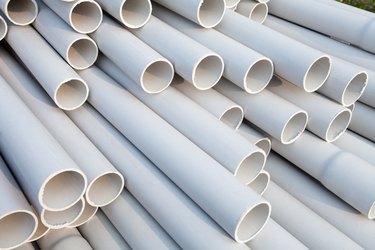
For your plumbing and ventilation needs, polyvinyl chloride (PVC) pipes offer the best in performance, versatility, durability, and affordability. But when you walk down the pipe aisle at your local hardware store, you might feel confused about the various numbers and sizes. Fortunately, it only takes a few minutes to understand the different types and sizes of PVC pipe.
Types of PVC Pipes
Video of the Day
PVC pipes are typically categorized into two different types: schedule 40 and schedule 80. The difference lies in the thickness of the pipe wall. Schedule 40 PVC pipes have thinner walls than their schedule 80 counterparts. If you come across a different schedule number than the typical 40 or 80, know that the higher the number, the thicker the pipe wall.
Video of the Day
Thicker walls come in handy for different pressure and temperature applications. To help you make the correct purchase, PVC pipes have their schedule and pounds per square inch (PSI) rating printed on the side.
PVC Pipe Sizes
PVC pipes typically come in sizes ranging from half an inch to 5 inches in diameter. Pipes with a 1.5-inch diameter commonly connect to sinks, whereas 3-inch pipes commonly connect to toilets.
Remember to look for fittings compatible with both the size and schedule of your pipes. Otherwise, the pipes won't fit into the joints or the connections will be too loose and therefore ineffective.
The Importance of Correctly Measuring PVC Pipe
Learning how to measure PVC pipes correctly can prevent fitting mistakes. In short, the number printed on the side of the pipe represents its inside diameter.
Hold a measuring tape up to the end of a 1.5-inch pipe and note that the pipe measures closer to 2 inches from outside edge to outside edge. However, the inner diameter measures 1.5 inches. Of course, pipes with higher schedules have an even larger outside diameter due to thicker walls, but the inside diameter of all 1.5-inch PVC pipes remains 1.5 inches.
What's CPVC?
Chlorinated polyvinyl chloride (CPVC) represents another pipe used in plumbing, but don't make the mistake of using CPVC and PVC interchangeably, even though they share part of their name.
CPVC has a smaller diameter and a yellowish tint, a feature that can help you quickly differentiate these two cousins. The two even require different fittings and glue. Use CPVC for water supply lines due to its ability to handle much higher pressures than PVC.
Now you can march confidently into the pipe aisle, breeze right past the deceptive CPVC, and choose the correct size and schedule PVC without missing a beat.